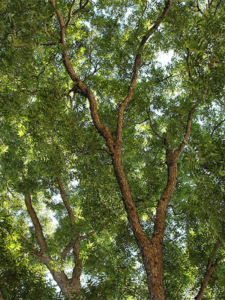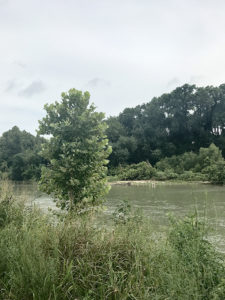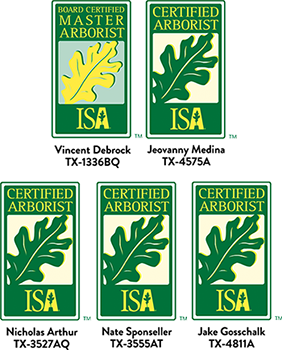You own a place in the country – or maybe you’re considering buying land in Bastrop County, Texas. Even if you’ve owned property before, chances are you’re curious about the differences between trees in a city and those on rural properties.
More trees means special planning and care so you can enjoy them for many years. In this article, we’ll address common questions about Bastrop tree care, and the challenges and pleasures of owning forested land in Bastrop and adjoining counties.
Questions About Tree Care in Bastrop
- Which native trees are growing on my property?
- What do trees need and how do I keep them healthy? Do I need an arborist?
- Can I make my property resistant to wildfires and still keep the trees?
- How can I protect my trees during construction?
Post Oaks and Blackjack Oaks dominate the vegetation but you may have Loblolly Pines if you’re in the Lost Pines area.
The Post Oak Savannah favors the sandy soils while you’ll find water-tolerant hardwoods, cottonwoods, and Black willows near rivers and creeks. As you move up the tributaries and away from floodplains, you see hackberry, elm, yaupon, mesquite, and Eastern Red Cedar.
Your property may contain a mix of native trees, naturalized trees, and favorites that earlier owners planted. Native trees grow without cultivation; this happens when a naturalized tree escaped cultivation and now grows wild.
“Trees don’t just give a sense of place, but also of time, history and ultimately of belonging.” — Vincent Debrock, Co-owner Heritage Tree Care & Senior Arborist/Consultant
What kind of trees are on my property?
There are over 90 species of trees growing in Bastrop County! If you’d like more information beyond what we’ve listed below, or need further help identifying each type visit this tree identification site. It has a comprehensive list with pictures and focuses solely on trees in Texas.

Beautiful Loblolly Pine on the property of Tammy Brown in Bastrop County, Texas. Visit her blog at Lost Pines Life.
Loblolly Pine
If you are on the eastern side of the Colorado River, you may be fortunate to have Loblolly Pines (Pinus taeda). This tree grows quickly under suitable conditions and reaches 60 feet in 20 years, maturing to nearly 100 feet. It has a deep taproot and flexible trunk and is among the most wind-resistant trees. It will not grow in alkaline soil and needs sandy or gravelly well-drained soil.
The needles are flammable and shed all year long. Property owners should trim lower limbs that sweep the ground to reduce “ladder fuel” and prevent fire climbing to the treetops.
Blackjack Oak
There are at least 15 species of oaks native to Bastrop County. Blackjack Oak (Quercus marilandica) is a small, slow-growing oak, with big leaves. You’ll find it in well-drained gravelly or sandy locations. It doesn’t transplant well and is susceptible to damage when we change its habitat.
Post Oak
Another slow-growing native is the Post Oak (Quercus stellata). A tree two feet in diameter may be 100 years old or more. If mature ones are doing well on your property, you will want to save them. Their rugged appearance adds a sense of permanence but they are very susceptible to root disturbances. You must protect them during construction.
Live Oak
There are Live Oaks (Quercus virginiana) but not as many as you will find in the Edwards Plateau. It is relatively easy to establish in most soils but hard to maintain. It needs frequent pruning, drops leaves all year, and is susceptible to Oak Wilt. Live Oaks can live over 1,000 years and are slow growing. As with the Post Oak, if you have one or more of these on your land, professional advice will help.

A healthy sycamore tree with vines growing up the trunk in Bastrop, Texas.
Chinkapin Oak
The relatively fast-growing Chinkapin Oak (Quercus Muhlenbergia) is a beautiful tree for a large property; it can grow up to 80 feet tall and 40-60 feet in width. Sensitive to standing water, it flourishes in well-drained soil. An added benefit- it’s resistant to Oak Wilt.
American Sycamore
If you have streams or low-lying areas, you may have an American Sycamore (Platanus occidentalis) A huge tree, up to 100 feet tall and 50 feet across, it has large leaves and mottled bark which flakes off as the tree ages. They need plenty of room for their roots and can be susceptible to disease and insects.
Cedar Elm
Shade trees that grow 30-60 feet tall, Cedar Elm (Ulmus crassifolia) and Winged Elm (Ulmus alata) grow moderately fast and tolerate drought. Both produce plenty of seeds that wild turkeys and squirrels enjoy.
Eastern Red Cedars
You probably have Eastern Red Cedars (Juniperus virginiana) on your property. Not everybody likes them, but they are easy to grow in any soil, need little water and can reach a height of 50 feet. They are highly flammable so don’t plant them close to buildings.

Mature Texas pecan tree. Image © 2013 Larry D. Moore courtesy Wikimedia.
Pecan
Pecan (Carya Illinoinensis) is a large shade tree and the state tree of Texas. It grows in any well-drained soil and other than ugly webworms which don’t hurt the tree, it has few problems. This is an excellent tree which also produces delicious nuts.
Honey Mesquite
Honey Mesquite (Prosopis glandulosa) survives and spreads over most of Texas and Bastrop County is no exception. They provide filtered shade and their delicate, fine-textured leaves complement a xeriscape garden. Drought tolerant, you can kill them with too much water.
Tell Me More
The Ladybird Johnson Wildflower Center has a comprehensive database of Texas native plants and is searchable by county. Native plants have adapted to local conditions of weather, soil, pests, and diseases and tolerate extremes of climate while preserving a sense of regional identity. You can reduce the costs of landscaping and maintenance while wildlife enjoys increased habitat and food.
Benefits of Trees on Your Rural Property
For those living in rural areas, forests play a major role. Trees stabilize and prevent the soil from washing away and polluting streams and rivers. They hold banks in place and maintain healthy soil.
Tree canopies intercept rainfall, lessening the impact of raindrops on soil protected by forest leaf litter, tree roots, and other understory vegetation. Precipitation trickles through the natural mulch, recharging aquifers and reducing flooding.
Private individuals own 94% of the land in Texas and have a responsibility to do their part to preserve wildlife and healthy forests for future generations to enjoy.
So, if you are fortunate enough to own property with mature trees, protect them and make sure they continue to flourish. Large trees add about 15% to the actual value of your property and take many years to reach substantial size; they’re difficult to replace.

Mature trees add beauty and preserve the landscape, like these pine trees on the private property of Tammy Brown. Image courtesy Tammy Brown Art.
How an Arborist Can Help
A Certified Arborist is a professional trained to understand the biology and care of trees. With extensive education and experience, he can help you choose the best species and location for each tree and provide care for the lifetime of the tree.
In the long run, it’s essential to consult a certified arborist before you begin construction, change roadways or drainage patterns. As with most things, “prevention is better than cure”. An arborist can help you decide which trees to keep, how to take care of them during construction and help you design a landscape that will keep your trees healthy for years.
What Do Trees Need?
To understand how important comprehensive tree care is, let’s look at a few essentials. When we see a tree, it’s easy to focus on the trunk, branches, and foliage – the parts that are visible. More critical are the parts we can’t see, the roots and the soil.
Every tree requires:
- Well-drained, aerated soil.
- Healthy, balanced soil containing organic material and abundant living organisms.
- Moisture, neither too much nor too little.
Soils in Bastrop County often resemble a beach. Locals call this soil, sugar sand, because of its extreme fineness. It has few mineral nutrients and little organic matter. It drains well, often too fast. Under the sand is clay which holds moisture and has some nutrients, but compacts easily and is poorly aerated.
McDade and Smithville soil is rocky and gravelly. If you have property near the Colorado River, you can find fertile loam prone to flooding. Rocky and gravelly soils will compact the least but also don’t have much organic material.
Take Care of the Trees You Have
If you have healthy, native trees growing on your property, your first challenge is to not harm them by changing their environment and damaging them. You may want to clear out some of the forests to add pasture, for building, or to reduce the likelihood of forest fires and you’ll want to plan ahead.
As part of a tree survey, we can tell you which trees are the healthiest and most likely to tolerate change. If you have large oaks and pine trees, we can work with you to be sure they stay healthy and beautiful.
“The saddest thing is when owners call us several years after the fact when trees have lost their canopy density. At that stage, the tree is close to dying, and it will take years to recover a canopy if it does not contract a terminal disease or succumb to opportunistic insects.” — Vincent Debrock, Co-owner of Heritage Tree Care and Senior Arborist/Consultant
Trees and Construction Damage
Damage during construction may not show until years later. Construction equipment can hit trees and break branches, but the greatest danger of injury is underground.
- The roots of a tree may cover an area larger than the height or spread of the tree. The upper few inches of soil contain most of the essential feeder roots.
- Soil compaction causes the most damage. Equipment and vehicles crossing the site crush the tender roots.
- Traffic over the root zone changes the texture of the soil, so it does not absorb water and oxygen easily. Remember- the roots and microorganisms that feed the tree need air, water, and pores in the soil.
- When a contractor changes the grade of the land and piles extra soil on top of roots, it can smother them. Lowering the existing soil surface can cause excess water to accumulate around roots and drown them.
- As all these subtle injuries build, the tree can become stressed and succumb to disease, insect attack, and malnutrition.
Plan To Save Your Trees

Trees in Bastrop, Texas at the county courthouse.
Cities in Bastrop County do not have an official Tree Ordinance, unlike larger cities such as San Antonio, Houston, San Marcos and Austin. As the landowner, you need to work with your architect and contractor to make sure they follow a Tree Protection Plan.
If your property is in the north-eastern section of the county, it may be part of the habitat of the endangered Houston toad. Visit the County of Bastrop information page for how this designation may affect your property development plans.
Certified Arborists at Heritage Tree Care have many years of experience working with homeowners, architects, contractors, and landscape designers. We can collaborate with the team to decide which trees you want to protect or remove to maximize views and give access to the property.
When the design and tree inventory is complete, a written Tree Protection Plan (TPZ) will detail where barriers and parking should be and marks the TPZ with temporary fencing. The goal is to keep people and equipment as far from each tree or group of trees as possible. After the project is complete, we will assess each protected tree and apply remediation if needed.
As you work on plans for your property, don’t forget to include wildfire mitigation procedures.
Firewise Landscaping

More information about protecting your home from wildfire using landscaping is available here: How to Protect Your Home From Wildfire by Heritage Tree Care.
In 2011, the most destructive wildfire in Texas history roared through parts of Bastrop County. The accumulated effects of years of drought, build up of fuel in the forest, and record temperatures created a holocaust: 1,673 homes destroyed, two people killed and 32,400 acres burned.
As a result, property owners are even more aware of including wildfire preparedness in their landscaping plans
Heritage Tree Care offers a Fire Preparedness Program which can decrease the likelihood of structure fires while maintaining the tree canopy. Our experts can recommend landscaping, steps to reduce the “flame ladder” and prevent points of contact between vegetation and buildings. We find gaps where embers can enter structures, a leading source of ignition.
Property owners can still include trees and wildlife habitat if kept a safe distance from structures. Visit firewise.org for more information on the zone concept for wildfire mitigation and helpful landscaping tips.
Have more questions about tree care?
We hope you found this information helpful and enjoyed learning more about tree care in Bastrop County. If you’d like to schedule a personal consultation with one of our certified arborists who will visit your property to evaluate and discuss the care and health of your trees, please give us a call at 512-921-8452. We’re happy to help.





